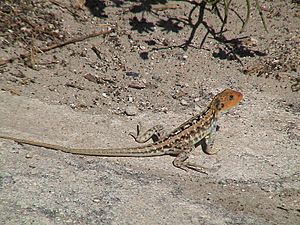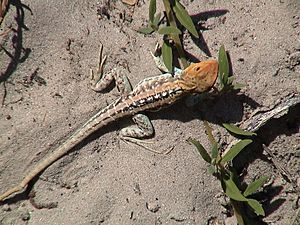Painted ground-dragon facts for kids
Quick facts for kids Ctenophorus pictus |
|
|---|---|
 |
|
| Ctenophorus pictus, painted dragon | |
| Scientific classification | |
| Genus: |
Ctenophorus
|
| Species: |
pictus
|
| Synonyms | |
|
|
The Ctenophorus pictus, also known as the painted dragon, is a type of lizard. It belongs to the Agamidae family. These lizards live only in the dry parts of southern and central Australia.
Contents
What Does the Painted Dragon Look Like?
The painted dragon is a medium-sized lizard that lives on the ground. It has a short, deep head. Its body scales are smooth and mostly the same size.
These lizards can look very different from each other. They come in many color mixes. Adult males can be brown, yellowish-brown, orange, or reddish-brown. They often have pale stripes or spots with dark edges. These patterns are usually over a dark stripe down their back. Their sides might have spots or net-like patterns. Their legs are also patterned. The tail pattern is often hard to see, but it has dark bands near the body.
When it's time to breed, male painted dragons get bright colors. Their lower lips, throat, and legs turn bright blue. Their chest and shoulders become bright yellow or orange. Female lizards and young ones are not as colorful. Females are often a rusty brown color.
The scales feel smooth when you touch them. Males sometimes have a small crest on the back of their neck. They can raise this crest when they feel scared. There are also slightly bigger scales along their back. Their ears are easy to see on the side of their head. They have large, clear eardrums.
Adult painted dragons grow to be about 18 to 25 centimeters (7 to 10 inches) long. Their body, from snout to vent, is about 7.5 centimeters (3 inches). The tail makes up about 65% of their total length.
Where Do Painted Dragons Live?
Painted dragons are found in the dry areas of southeastern Western Australia. They also live across South Australia to northwestern Victoria. You can find them in central-western New South Wales too. They like places that are semi-dry or very dry. They prefer shrublands and grassy areas with sandy or salty soil.
How Painted Dragons Live
Painted dragons are fast reptiles, like most agamids. They can run very quickly for short distances. These lizards are active during the day. Like most reptiles, they are ectotherms. This means they use their environment to control their body temperature. They spend a lot of time basking in the sun to get warm.
They really like low plants and things on the ground, like fallen logs. They often hide in short burrows. These burrows are usually at the bottom of shrubs, like saltbush. Unlike many other agamids that like to sit high up, painted dragons prefer low branches. From here, they look for food in the open areas around them. If they feel bothered or scared, they quickly run back to their burrow.
Painted dragons have many traits common to the Agamidae family. They are very alert lizards. They stand upright and have great eyesight. They use their vision to find food, look for mates, and watch out for enemies. They communicate mostly by moving their bodies. This includes head bobs, arm waving, and tail lashing. When they hunt for food, agamids grab their prey with their short, thick tongue. They don't use their jaws as much.
What Do Painted Dragons Eat?
Painted dragons use a "sit-and-wait" hunting method. They use their sharp eyesight to spot prey by its movement. Because of this, they mostly eat active, moving creatures. Their diet is mainly made up of arthropods, which are insects and similar creatures.
A strange thing about the Agamidae family is that many of its species eat ants. Other lizards often avoid ants. Scientists think this is because ants are easy to find, not because they prefer them. It's still a mystery why they eat ants at all. Many other lizards avoid ants because of the formic acid they contain. It's thought that painted dragons have found a way to deal with this chemical.
While these lizards mostly eat insects, painted dragons in zoos have been seen eating a lot of plants too.
Why Males Have Different Colors
Male painted dragons can be different colors. They can be reddish-brown, orange, or yellowish-brown. Orange is the least common color. Scientists have put them into three groups based on their main color: red, orange, and yellow.
Female lizards often choose red-colored males to mate with. This is called sexual selection. The red color might show that the male has good genes. For example, red males might have higher testosterone levels. This can help them fight off predators. It also helps them defend their territory and their young.
Red males have more testosterone than yellow males. Testosterone is linked to being aggressive. Red lizards with more testosterone are better at fighting. They also use more aggressive ways to get more chances to mate than yellow males. Red males also defend their territory more strongly. They start doing this earlier in the year. This gives them an advantage over yellow males. However, being so aggressive and defending territory early takes a lot of energy. This can make them less fit overall.
On the other hand, yellow males tend to live longer. This might be because they use less energy defending their territory. Yellow males also have more sperm than red lizards. They usually have bigger testes and mate for shorter times. When yellow males mate, they have about three times as many babies as red males. Both red and yellow males survive well. This might be why both color types are still found in painted dragon groups.
Even though females often prefer red males, natural selection helps keep the yellow males around. This is because yellow males use energy more efficiently. Both color traits help the lizards survive and reproduce. This explains why painted dragons have different colors.
Images for kids



